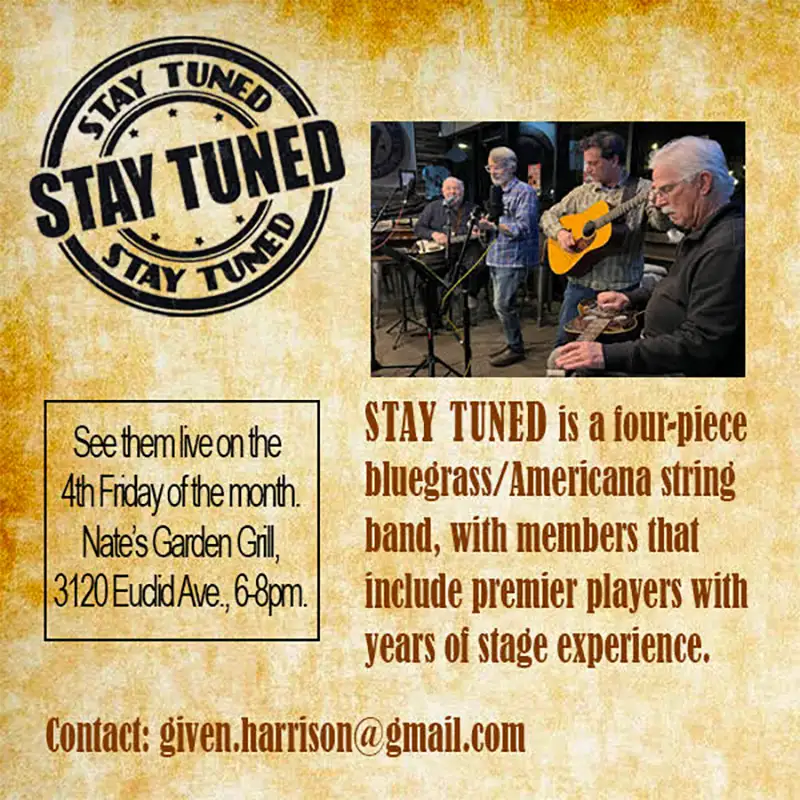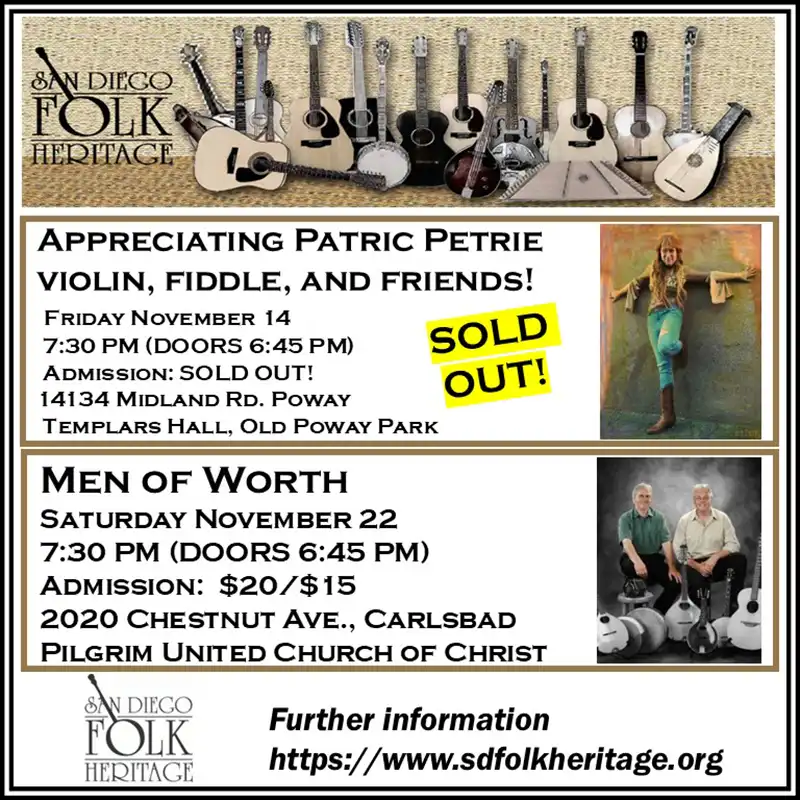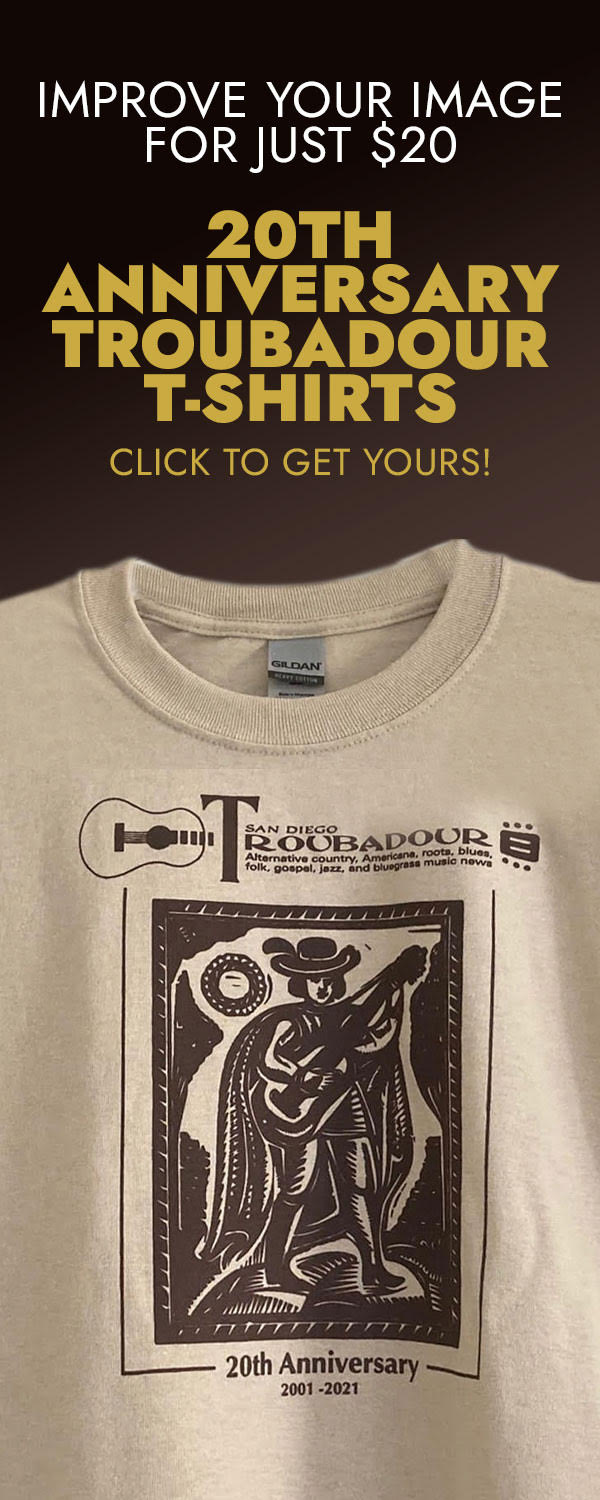Featured Stories
The Mesmerizing Sounds of Klezmer
How traditional Jewish music came to America and where it found new generations of listeners.
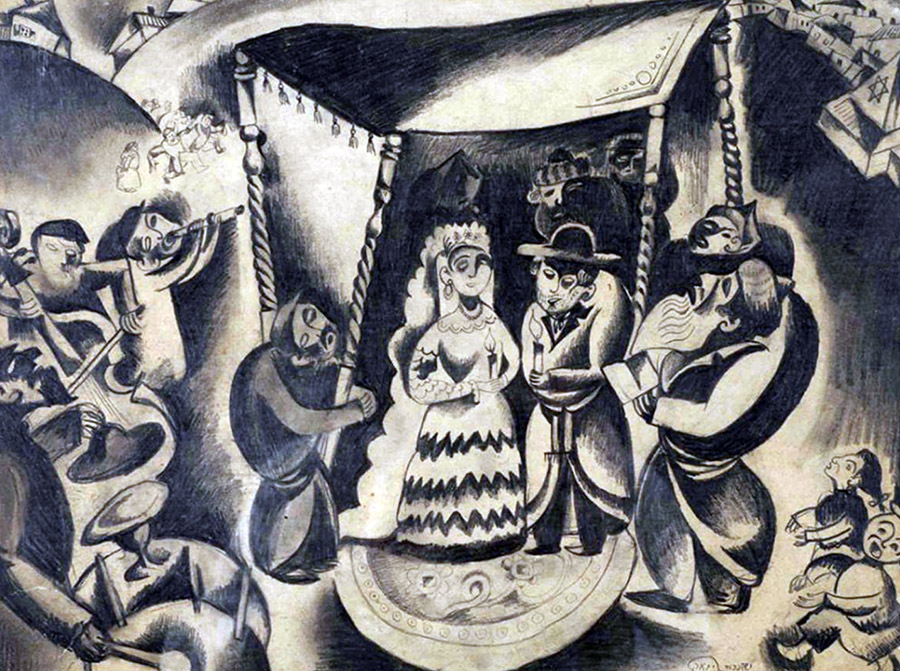
Klezmer is associated with celebratory occasions, particularly weddings, and is known for its danceable beats and imporvisational style. Illustration by Issachar Ber Ryback, 1917.
Whenever the [evil] spirit of God came upon Saul, David would take the lyre and play it; Saul would find relief and feel better, and the evil spirit would leave him. (1 Samuel 16:23)
Music has been a vital part of Jewish culture since biblical times. The first Jewish musician mentioned in the Bible is Jubal, son of Lamech, who played the harp and organ. The ancient Jews believed that music held magical powers and could inspire the performer and listener to great spiritual ecstasy. It could even help foretell the future and treat mental illness. Yet some strands of Jewish culture were opposed to music.
After the destruction of the Second Temple by the Romans in 70 CE, Jews were dispersed throughout the world, and rabbis banned all instrumental music in an act of self-imposed mourning for Zion, a prohibition that was to be lifted only once the Messiah came to rebuild the Temple. The rabbis of that era associated any kind of secular music with the decadence of Greek culture. For them it was synonymous with obscenity and chiefly used for carnal purposes on frivolous occasions. These extreme attitudes persisted through the seventeenth century, helping create a negative stance toward Jewish folk instrumentalists in their communities. But even the most orthodox rabbi, wherever he lived in Europe, was unable to completely shut his congregants off from music. Though Jews were forced to live in ghettos at the end of the Middles Ages, they still heard plainchant and polyphonic religious music as well as folk music and other secular songs from wandering troubadours. Most of these minstrels were Christians but some were Jewish, including two of the most famous Provençal troubadours of the thirteenth century, Bonfils de Narbonne and Charlot le Juif, and the German minstrel Susskind von Trimberg.
How klezmer music got its start is made more mysterious by the history of the word klezmer. There is a great deal of confusion about when the term (a Yiddish word derived from the Hebrew kĕlēy zemer, meaning “tools of the music”) began to denote the Jewish musician and a specific type of music rather than the instrument being played. In the Maharil of Mainz’s (Rabbi Jacob ben Moses Mollin, 1360–1427) book of marriage laws, he used klezmer to denote musical instruments. But by 1707, the year the first Yiddish song book, Simkhat HaNefesh, was published in Fürth, Germany, its author, Rabbi Elkhanan Kirchen, was referring to the Jewish musician as a klezmer, using the Yiddish word that now refers to a musician who plays klezmer and other genres of folk music. His book’s title, which translates from Hebrew to “Happiness of the Soul,” is fitting, given klezmer’s association with celebratory occasions, particularly weddings. The music’s distinctive sound is shaped by its Middle Eastern scales, as well as its ornamentations—glissandi and grace notes—that were used by cantors during prayer singing and then incorporated by Jewish minstrels.
It is known that klezmer bands at this time consisted of a violin, second violin (or viola), bass (sometimes cello instead), hammer dulcimer (tsimbl), clarinet, and bass drum with a small cymbal. But as czarist Russia conscripted Jewish musicians from Poland, Ukraine, Belarus, and Lithuania following the third partition of the Polish-Lithuanian Commonwealth in 1795, these string and tsimbl players branched out to woodwinds and brass. By the last third of the nineteenth century, klezmer musicians were incorporating the flute, trumpet, and trombone into their performances.
Klezmer performed today can be classified into two dominant styles. The first is the Polish-Ukrainian repertoire, which consists of marches, waltzes, polkas, and mazurkas, as well as freylekhs—lively circle or line dances—and skotshnes, which were introduced to Jewish weddings by musicians who played at Polish and Ukrainian gentile celebrations. The second style—considered by some to be the most influential today—is called Romanian-Turkish, a type of playing that originated in eastern Hungary, the Carpathian Mountains, Moldova, Romania, and its former province of Bukovina, representing a more Near Eastern sound with such dances as zhoks, horas, sirbas, and doynes. The best-known purveyor of this latter style of klezmer playing in the twentieth century was the musician Dave Tarras.
David Itsy Tarasyuk—he would shorten his last name after immigrating to the United States—was born on March 15, 1897, in the Russian city of Ternovka (now Ternivka, Ukraine). Tarras came from a long line of klezmer musicians. His father, Rakhmiel, who played the valve trombone, was a wedding bard and the leader of his family band, where Dave learned to play the balalaika and the flute.
In 1913, his father sent his teenage son alone to Uman, 45 miles to the west of Ternovka, to learn to play the clarinet. The trip was a short one, lasting only a few weeks from the beginning of the Jewish New Year through the holiday of Sukkot, but it was life-changing. While he was there, Tarras encountered a number of different Hasidic sects, including the Bratzlav and Vizhnitz, whose many beautiful melodies Tarras would appreciate and play during his entire life. (In addition to these Hasidic influences, Dave and his father’s ensemble met and performed with Romani musicians, and Dave learned many melodies from the Roma, which he played throughout his entire career.) When Tarras came home, his father brought him to play his C clarinet at a gentile wedding. Everyone was quite impressed at the beautiful tone the young man was able to produce after only three weeks of private lessons.
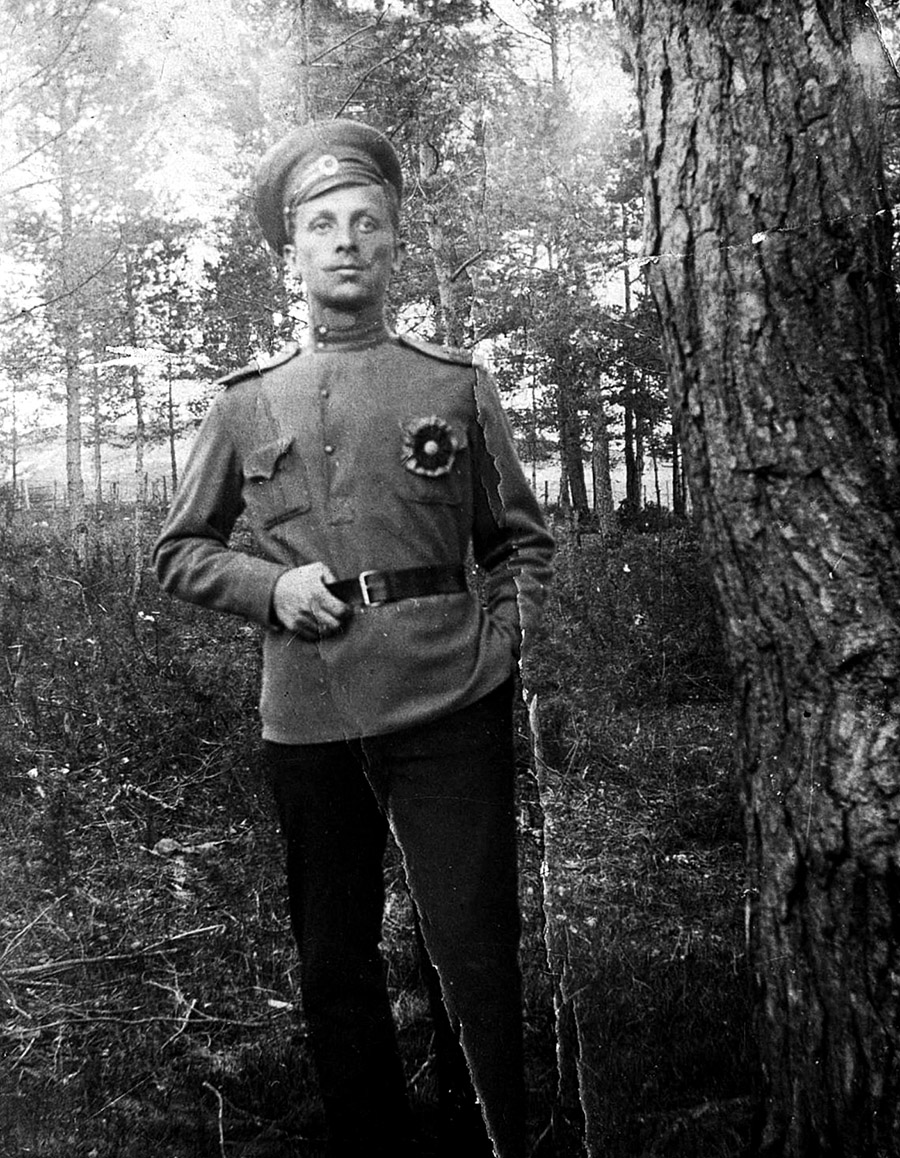
At the age of 17, Tarras was drafted into the czarist army, where his skills as a musician immediately caught the attention of his commanding officer and earned him a substantial raise. Photo courtesy of Yale Strom.
World War I broke out a year later, and all of Europe, including Russia, was soon engulfed in the conflict. But one area of relative safety in the czarist army was the military orchestra. In 1915, when Tarras was drafted at age 17, he immediately let his commanding officer know he was a musician. The commander asked Tarras to play the mandolin during a concert with the mandolin orchestra, and when Tarras took a solo he received huge applause. The next day the commanding officer sent him to St. Petersburg to buy a new clarinet, violin, guitar, and mandolin. At that time, the soldiers were getting 90 cents a month, but in recognition of Tarras’s extraordinary gifts the commanding officer gave an order that Tarras’s monthly salary should be increased to ten dollars. It was an unbelievable stroke of luck. His experience was better than that of most Jewish soldiers who had to serve in the czarist army. Being able to play several instruments and read music made Tarras a vital commodity to the officers’ corps. At night, while he entertained his superiors, the rest of his brethren were on the front fighting the Germans. For a while, music shielded Tarras from the horrors of the war.
After the Bolsheviks defeated the czar in 1917, an intermittent military struggle waged for the next four years as Ukrainian independent forces and pro-Bolshevik elements each sought to rule Ukraine. As pogroms increased against the Jews, who were looked upon by the Ukrainians as supporters of the Bolshevik revolution, thousands fled in terror across the border to Romania, Germany, and eventually to the United States. In 1918, Tarras, who was now married, joined them. With his new wife and her niece, he slowly trekked across Europe to Germany, where they bought tickets for a steamer to bring them to the United States in 1920.
In New York City, Tarras worked as a janitor cleaning up the waste in his brother-in-law’s fur shop while he trained to learn the furrier trade; he simply assumed he was not good enough to be a professional musician in America. Eventually, however, Tarras began to get a few wedding jobs through a cousin who played the trumpet. And it was one of his first gigs with a violinist named Sam Ash—who would later go on to make his name in the music business, selling instruments, sheet music, and sound equipment throughout the United States—that convinced Tarras he had what it took to be a musician in his new country. “I’ll tell you a little story about this Sam Ash,” Tarras recalled in an interview with his son, Sy, in the 1970s:
Sam Ash used to play khasenes [weddings]. He was playing a little fiddle… so the first two years when I started to play with my cousin, Ash engaged me to play a wedding… There were four other musicians who joined me. The leader was this Sam Ash who played so badly on the fiddle he couldn’t keep tempo on the chorus. So, I thought to myself, this is America, this is how musicians in the United States play?… Finally, at about 11 p.m. the people were sitting for supper. There under the piano I see a fiddle on the ground so I played a couple of tunes… So this Sam Ash asks me: “Yinger [young] man, you’re working in a furrier shop?” I said, yes, that I needed to make a living because I had a wife and I had a child, my first daughter. He says: “Why don’t you do what I do?” I said, “What are you doing?” He says, “I teach, I give lessons on the violin. After teaching the boy for a year the mother says the teacher is no good and I say the pupil is no good. I get new students and she gets other suckers. You could be a teacher on the violin and make a nice living, too.” So, I told him the country where I come from for a musician to be able to teach music, he himself has to be a good musician.
Tarras began to get hired for more music work, including a stint at the Brooklyn Fox and Paramount movie theaters on Haven Street in Brooklyn, playing accompaniment for silent films, where he served as first clarinet in an ensemble of some 40 to 50 musicians, impressing the three other clarinetists in his section with his ability. When they asked him where he had learned to play and he explained that he had taken lessons in Uman for only three weeks, none of them believed him. From that moment on, he never told the truth about his studies again.
By the early 1930s, Tarras was known throughout the Yiddish theater and klezmer world as the best clarinetist on the East Coast. But, during the Depression, radio and theater jobs did not provide enough income for a klezmer musician, and he had to be enterprising to find enough work to support his wife and three children. A typical weekday entailed playing for two different Jewish radio shows, then going to a Jewish fraternal organization, and then performing at a private event and at a labor union party until the wee hours of the morning. On the weekends he could sleep in after arriving home very late from a wedding job. Tarras loved his family, but he was devoted to his music. He spent his free time making his own clarinet reeds, writing music arrangements, and working at the local 802 music union.
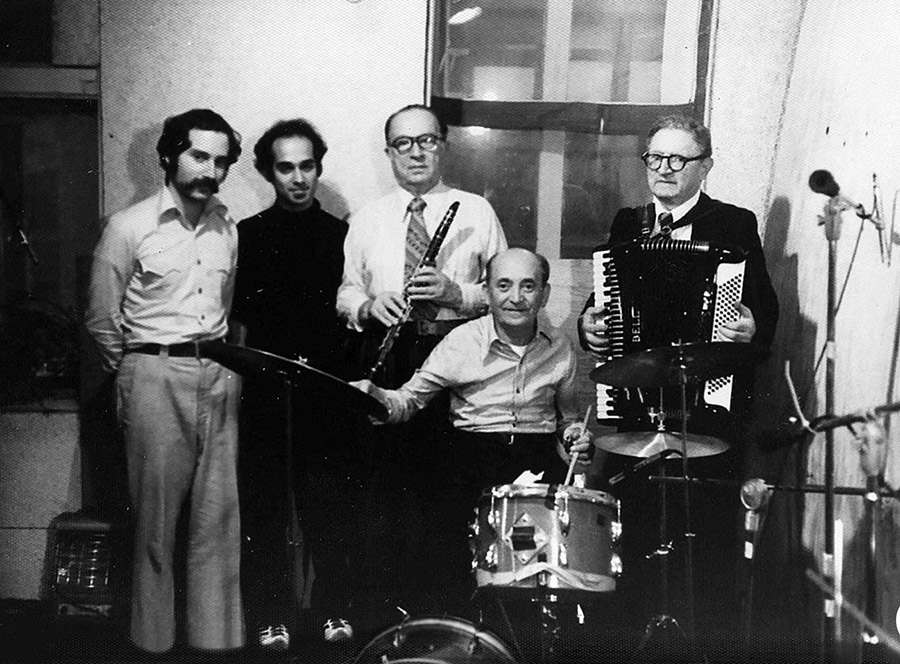
Tarras (ca. 1976) with bandmates Irving Graetz (drums) and Sammy Beckerman (accordion), along with musicians Zev Feldman (left) and Andy Statman (right). Efforts by Feldman and Statman to promote Tarras’ music helped spur a klezmer revival in the 1970s. Photo courtesy of Yale Strom.
After World War II, much of American Jewry turned away from wanting anything to do with Yiddish culture, finding it a constant reminder of the millions who were murdered in the Holocaust, and focused instead on new Israeli music with Hebrew lyrics. By the 1940s and ’50s, klezmer music had been all but relegated to the Hasidic enclaves of Brooklyn and to Florida’s “condominium circuit,” populated by aging first-generation Jews transplanted from New York City who wanted to be bathed in nostalgia for the “old country” or their tenement memories.
Though the heyday of klezmer had passed, a significant core of immigrant Jews in the New York region still enjoyed listening to it while vacationing in Jewish hotels in the Catskills. When Tarras played at these venues, he occasionally crossed paths with famous jazz musicians who had heard of his virtuosic musical skills. The youngest member of his band, trumpeter Sheldon “Shelly” Hendler, who played with Tarras during the 1950s, would later describe one particularly memorable encounter at the Loch Sheldrake Inn in New York.
The hotel owner’s son Allen Eager, Hendler said, “was one of the great tenor saxophone players of that era. He would invite all of his friends to come up for a week or the weekend and hang out… and listen to Dave Tarras… Some of the people I am talking about included Charlie Parker and Miles Davis.” The famous jazz trumpeter Red Rodney and others, Hendler recalled, had told him how “Charlie Parker said Dave was an incredible musician and had great improvisational skills. They weren’t interested in any of the American stuff he played—they were interested in only the modal stuff Dave was playing.” The legendary jazz masters were impressed both with the unique Arabic sound of Tarras’s music and the virtuosic skill with which he played it.
Tarras managed to make a living, but it was not easy. Then, in the late 1970s, the revival of klezmer began. Young people who had grown up in the ’50s and ’60s, during the American folk music era, began exploring their own ethnic folk music. For some young Jews, this meant listening to the Yiddish and klezmer records of their grandparents.
In 1976, Tarras played a standing-room-only concert in Monsey, New York, where he shared the bill with the folk singer Rabbi Shlomo Carlebach. Most people in the audience were surprised to know Tarras was still living, since few had heard or seen him in the past 15 years. The event helped reintroduce Tarras’s name to the Jewish public in the Northeast.
Two years later, a concert at the Balkan Arts Center in New York City brought together Tarras’s old trio of Sammy Beckerman on accordion and Irving Graetz on drums for a reunion concert. The sold-out performance, which drew more than 750 people, included a set by Tarras’s famous former student Andy Statman (on clarinet) and Zev Feldman (on hammer dulcimer), both major figures in the klezmer revival. After the show, many people came up to Tarras to reminisce about their connections to him: He had played at their wedding, they said, or their parents’ wedding, or they had seen him in the Catskills. The performance put Tarras’s name back on the world map for klezmer musicians and enthusiasts. As the revival scene began to grow, Tarras was visited by a constant stream of musicians, journalists, historians, television reporters, and documentary filmmakers, who appeared at his doorstep in Brooklyn, many of whom came from abroad.
In 1984, nominated by President Ronald Reagan, Tarras received the highest honor in the United States for a folk musician, the National Heritage Fellowship, which was given to him by the National Endowment of the Arts. The presentation took place in Washington, D.C., at Ford’s Theater. During the next five years, as Tarras’s health gradually became more precarious, he left his home less frequently and played fewer concerts. The klezmer revival scene was by then a decade old. Several klezmer bands from America were traveling overseas, performing concerts as part of an effort to return klezmer to its Central and Eastern European roots. The interest and enthusiasm for Tarras and his music had only grown greater among musicians and his adoring public. Tarras represented that last link to the klezmer world of the late nineteenth and early twentieth century. Many ethnomusicologists and klezmer musicians scoured the sound archives of the YIVO Institute for Jewish Research and their families’ basements for old 78 RPM records. With Tarras they had a chance to ask questions of the very man who had played both as a soloist and as an ensemble player on records made during the golden age of early klezmer.
On February 12, 1989, just a month shy of his 93rd birthday, Dave Tarras passed away. When he died, an era passed away with him. Tarras influenced several generations of klezmer players, particularly clarinetists, and his work remains influential. There is hardly a klezmer band in the world today that does not play at least one of his compositions.
The power of Dave Tarras’s music is best summed up by an anecdote he once shared with Andy Statman:
I was the leader in the military band under the czar during World War I, and they had us play foxtrots and other tunes that were popular in the day. We would go into our trenches to play these patriotic tunes to prepare them, get our fellow soldiers into a frenzy before for battle. Well one time we were in our trenches, and I was leading the band. Several hundred yards across from us were the Germans quietly listening to the music, sitting in their bunkers. All you could hear was the music. After we finished playing, I heard applause.
Don’t miss the 23rd Klezmer Summit on June 27, 7:30pm, at the First Unitarian Universalist Church of San Diego, 298 W. Arbor Dr., San Diego.




